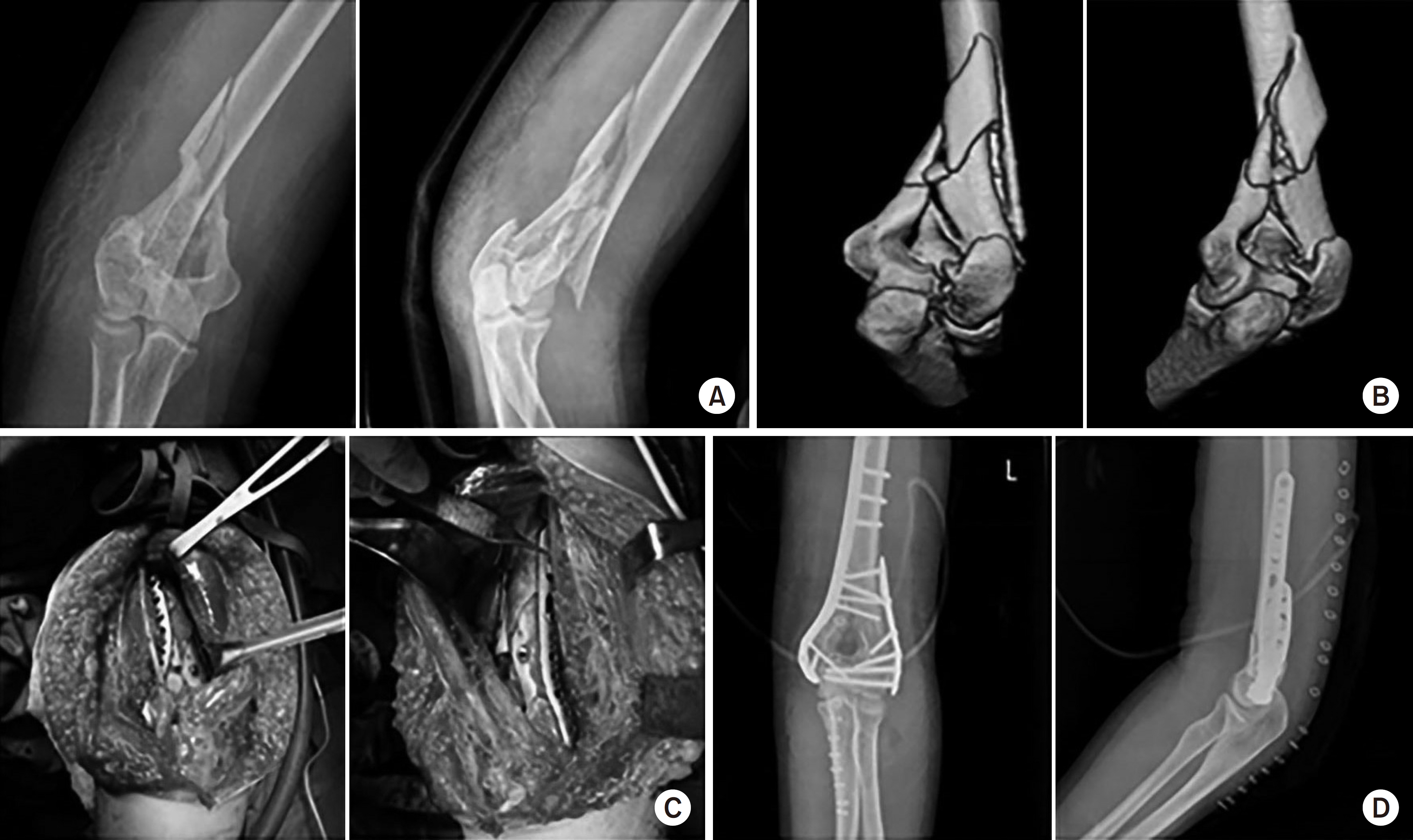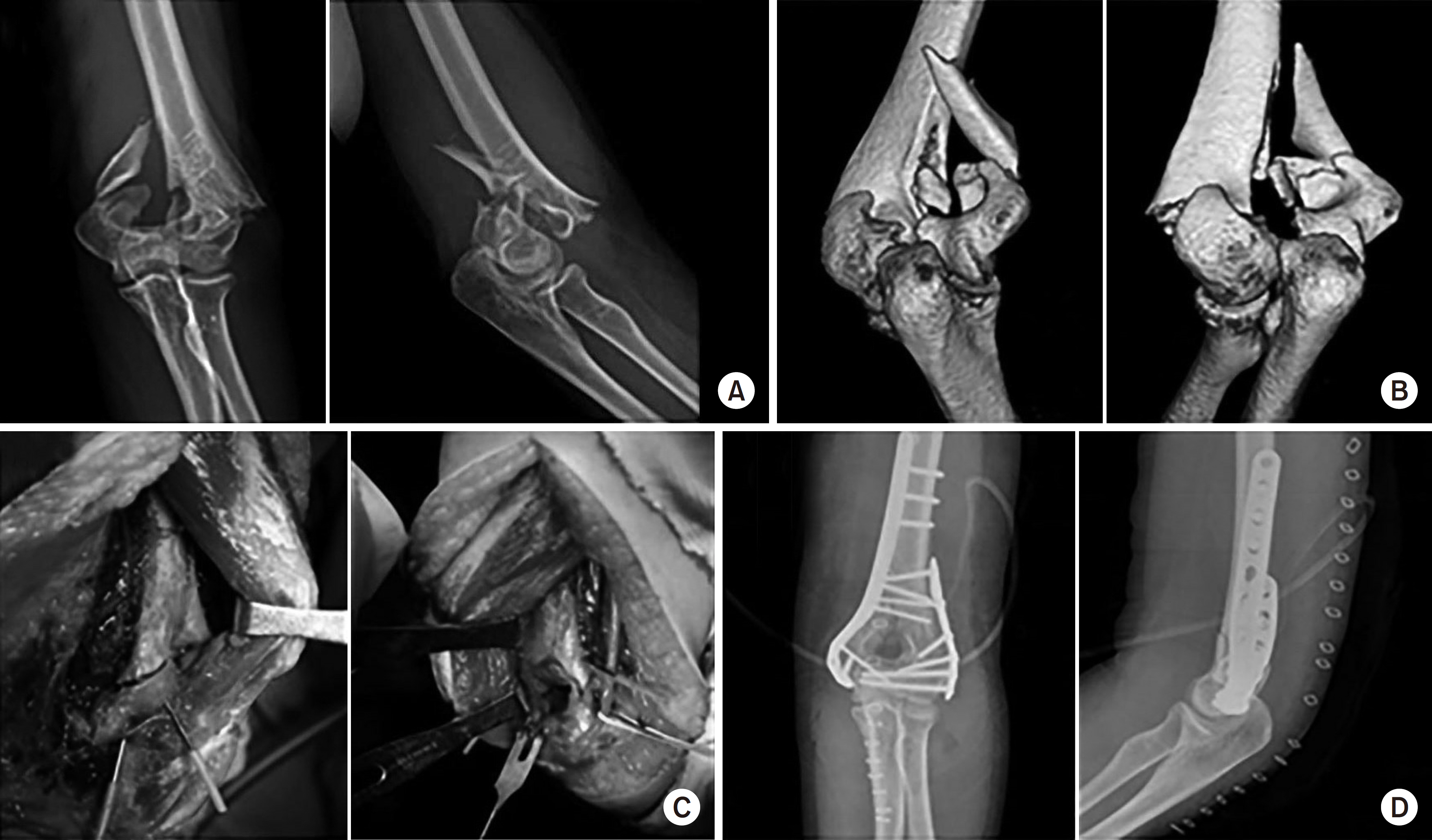J Korean Fract Soc.
2019 Jul;32(3):128-134. 10.12671/jkfs.2019.32.3.128.
Paratricipital Approach for AO/OTA Type C2 Intra-Articular Fracture of Distal Humerus
- Affiliations
-
- 1Department of Orthopedic Surgery, Daejeon Sun Hospital, Daejeon, Korea. mediiron@naver.com
- KMID: 2453065
- DOI: http://doi.org/10.12671/jkfs.2019.32.3.128
Abstract
- PURPOSE
The aim of this study was to determine the outcomes of fixation of AO/OTA type C2 fractures among intra-articular fractures of the distal humerus using the paratricipital approach (side to side retraction of the triceps).
MATERIALS AND METHODS
From June 2008 to January 2018, 12 patients underwent an open reduction and internal fixation with the paratricipital approach and were followed-up for more than 10 months after surgery. According to the AO/OTA classification, type C2 fractures were chosen among the intraarticular distal humerus fractures. An extended posterior incision was used over the olecranon in the prone position, preserving the insertion site of the triceps brachii muscle. The fracture site was exposed by retracting the muscle side-to side through a dissection of the medial and lateral intermuscular septum of the triceps brachii muscle. The therapeutic results were assessed by the anatomical reduction of the articular surface and integrity of the metaphyseal contour in postoperative simple radiographs, complications, such as neuropathy or non-union, and the Mayo elbow performance score (MEPS) were checked to estimate the functional outcome.
RESULTS
In the postoperative simple radiographs, no case showed more than 1 mm step-off and the disrupted contour of the distal humerus was recovered to normal alignment in most cases. The range of elbow joint motion in the last follow-up was 133.8° on average with a mean flexion contracture of 5.0°. The clinical results depending on the MEPS were excellent, except for two cases, which were good. Neuropathy of the ulnar nerve was observed in one patient, which was resolved after metal removal.
CONCLUSION
The paratricipital approach is useful technique in AO/OTA type C2 intra-articular distal humerus fractures that provides sufficient exposure of the surgical field, without injury to the triceps brachii muscle and postoperative complications associated with the trans-olecranon approach.
MeSH Terms
Figure
Reference
-
References
1. Yoon YC, Oh JK. Treatment of distal humeral fractures. J Korean Fract Soc. 25:223–232. 2012.
Article2. Sharma S, John R, Dhillon MS, Kishore K. Surgical approaches for open reduction and internal fixation of intraarticular distal humerus fractures in adults: a systematic review and metaanalysis. Injury. 49:1381–1391. 2018.
Article3. Ali AM, Hassanin EY, El-Ganainy AE, Abd-Elmola T. Management of intercondylar fractures of the humerus using the extensor mechanism-sparing paratricipital posterior approach. Acta Orthop Belg. 74:747–752. 2008.4. Schildhauer TA, Nork SE, Mills WJ, Henley MB. Extensor mechanism-sparing paratricipital posterior approach to the distal humerus. J Orthop Trauma. 17:374–378. 2003.
Article5. Zalavras CG, Papasoulis E. IntraArticular fractures of the distal humerus-a review of the current practice. Int Orthop. 42:2653–2662. 2018.
Article6. Brouwer KM, Guitton TG, Doornberg JN, Kloen P, Jupiter JB, Ring D. Fractures of the medial column of the distal humerus in adults. J Hand Surg Am. 34:439–445. 2009.
Article7. Jupiter JB, Barnes KA, Goodman LJ, Saldaña AE. Multiplane fracture of the distal humerus. J Orthop Trauma. 7:216–220. 1993.
Article8. Nauth A, McKee MD, Ristevski B, Hall J, Schemitsch EH. Distal humeral fractures in adults. J Bone Joint Surg Am. 93:686–700. 2011.
Article10. Wong AS, Baratz ME. Elbow fractures: distal humerus. J Hand Surg Am. 34:176–190. 2009.
Article11. Wilkinson JM, Stanley D. Posterior surgical approaches to the elbow: a comparative anatomic study. J Shoulder Elbow Surg. 10:380–382. 2001.
Article12. Zlotolow DA, Catalano LW 3rd, Barron OA, Glickel SZ. Surgical exposures of the humerus. J Am Acad Orthop Surg. 14:754–765. 2006.
Article13. Bryan RS, Morrey BF. Extensive posterior exposure of the elbow. A triceps-sparing approach. Clin Orthop Relat Res. 166:188–192. 1982.14. Kasser JR, Richards K, Millis M. The triceps-dividing approach to open reduction of complex distal humeral fractures in adolescents: a cybex evaluation of triceps function and motion. J Pediatr Orthop. 10:93–96. 1990.
Article15. Remia LF, Richards K, Waters PM. The Bryan-Morrey triceps-sparing approach to open reduction of T-condylar humeral fractures in adolescents: cybex evaluation of triceps function and elbow motion. J Pediatr Orthop. 24:615–619. 2004.16. Erpelding JM, Mailander A, High R, Mormino MA, Fehringer EV. Outcomes following distal humeral fracture fixation with an extensor mechanism-on approach. J Bone Joint Surg Am. 94:548–553. 2012.
Article17. McKee MD, Jupiter JB. A contemporary approach to the management of complex fractures of the distal humerus and their sequelae. Hand Clin. 10:479–494. 1994.
Article18. McKee MD, Jupiter JB, Bamberger HB. Coronal shear fractures of the distal end of the humerus. J Bone Joint Surg Am. 78:49–54. 1996.
Article19. O'Driscoll SW. Parallel plate fixation of bicolumn distal humeral fractures. Instr Course Lect. 58:521–528. 2009.20. O'Driscoll SW, Sanchez-Sotelo J, Torchia ME. Management of the smashed distal humerus. Orthop Clin North Am. 33:19–33. vii,. 2002.
- Full Text Links
- Actions
-
Cited
- CITED
-
- Close
- Share
- Similar articles
-
- Surgical Treatment of AO/OTA 33-C Intra-Articular Distal Femoral Fractures through Parapatellar Approach
- Triceps-Sparing Posterior Approach for Intra-articular Fracture of Distal Humerus
- Ulnar Nerve Injury Caused by the Incomplete Insertion of a Screw Head after Internal Fixation with Dual Locking Plates in AO/OTA Type C2 Distal Humerus Fractures
- Are Outcomes Comparable for Repair of AO/OTA Type 13C1 and Type 13C2 Distal Humeral Fractures Using the Paratricipital Approach?
- Treatment of Ankylosis of the Elbow Secondary to Failed Osteosynthesis of Intra-Articular Distal Humerus Fracture




